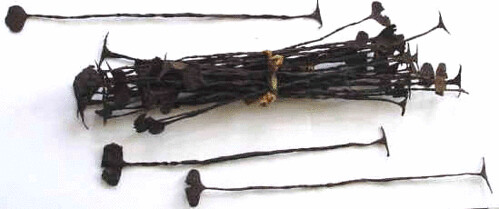
PREV ARTICLE
FULL ISSUE
PREV FULL ISSUE
FEATURED WEB PAGE: KISSI MONEYThis week's Featured Web Page is Kissi Money or ‘Money with a Soul'.
At the end of the 19th century, the so-called 'Kissi money' or 'Kissi penny' was introduced by the Kissi, Loma and Bandi peoples living in the border regions of nowadays Liberia, Sierra Leone and Guinea. In practice its use was quite extensive. Various sources mention the use of the Kissi money among and between the Bandi, Gbandia, Gola, Kissi, Kpelle, Loma, Mandingo and Mende tribes of this region. Presumably, Kissi money was 'minted' as from the 1880s by native blacksmiths who used iron smelted from the rich ore in the region. For many decades Kissi money circulated along with American, British and French paper money. The shape of the Kissi money is rather odd. Its characteristic form is a twisted rod of iron with flattened ends: a flat, hoe-like spatula at one end and a sharpened 'T' at the other. Its length varies from 9 to over 15 inches, the longer ones representing a higher value. Larger 'denominations' also were created by twisting several pieces together or bundling them and securing them with a cotton or leather strip. The odd shape may have its origin as a means of protection since it was virtually impossible to tamper with the metal content of the piece without noticing it immediately. If an iron rod would accidentally break, it could no longer circulate and its value could only be restored in a special ceremony performed by the Zoe, the traditional witchdoctor - often the blacksmith - who, for a fee, would rejoin the broken pieces and reincarnate the escaped soul. Therefore, it was said that Kissi money was 'money with a soul'.

www.liberiapastandpresent.org/kissi.htmWayne Homren, Editor The Numismatic Bibliomania Society is a non-profit organization promoting numismatic literature. See our web site at coinbooks.org. To submit items for publication in The E-Sylum, write to the Editor at this address: whomren@gmail.com To subscribe go to: https://my.binhost.com/lists/listinfo/esylum All Rights Reserved. NBS Home Page Contact the NBS webmaster 
|